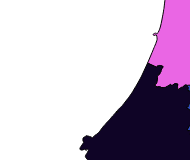Link general
QGSIS is a user friendly Open Source Geographic Information System (GIS) licensed under the GNU General Public License. QGIS is an official project of the Open Source Geospatial Foundation (OSGeo). It runs on Linux, Unix, Mac OSX, Windows and Android and supports numerous vector, raster, and database formats and functionalities.
QGSIS offers many common GIS functions provided by core features and plugins. A short summary of six general categories of features and plugins is presented below, followed by first insights into the integrated Python console.
See data with QGSIS:
You can view combinations of vector and raster data (in 2D or 3D) in different formats and projections without conversion to an internal or common format. Supported formats include:
- Spatially enabled tables and views with PostGIS, SpatiaLite, and MS SQL Spatial, Oracle Spatial, supported formats supported by the installed OGR library, including GeoPackage, ESRI Shapefile, MapInfo, SDTS, GML, and many more.
- Raster and image formats supported by the installed GDAL (Geospatial Data Abstraction Library) library, for example GeoTIFF, ERDAS IMG, ArcInfo ASCII GRID, JPEG, PNG and many more. See the Working with Raster Data section.
- GRASS raster and required data from GRASS database (location / map set). See the GRASS SIG Integration section.
- Online spatial data served as OGC web services including WMS, WMTS, WCS, WFS, and WFS-T. See the Working with OGC data section.
Explore data and compose maps with QGSIS:
You can compose maps and explore spatial data interactively with a friendly GUI. The very useful tools available in the GUI include:
- QGSIS browser
- Reprojection on the fly
- Database manager
- Print layout
- Overview panel
- Space markers
- Annotation tools
- Identify / select spatial objects
- Edit / view / search attributes
- Data-defined feature labeling
- Data-defined vectors and tools for raster symbology.
- Atlas and map composition with grid layers.
- North arrow, scale bar and copyright label for maps
- Support for saving and restoring projects
Create, edit, manage and export data with QGSIS:
You can create, edit, manage and export vector and raster layers in various formats. QGSIS offers the following:
- Digitizing tools for recognized OGR formats and GRASS vector layers
- Ability to create and edit multiple file formats and GRASS vector layers
- Georeferencing plugin to geocode images
- GPS tools to import and export GPX format, and convert other GPS formats to GPX or down / upload directly to a GPS unit (on Linux, usb: has been added to list of GPS devices)
- Support for viewing and editing OpenStreetMap data
- Ability to create spatial database tables from files with the DB Manager plugin
- Better handling of spatial database tables
- Tools for managing vector attribute tables
- Option to save screenshots as georeferenced images
- DXF export tool with enhanced capabilities to explore styles and plugins that perform CAD-like functions.
Data analize with QGSIS:
You can perform spatial data analysis on spatial databases and other OGR-supported formats. QGIS currently offers vector analysis, sampling, geoprocessing, geometry and database management tools. You can also use the integrated GRASS tools, which include the complete GRASS functionality of more than 400 modules. (See section Integracion GRASS SIG.) Or, you can work with the Processing Plugin, which provides a powerful geospatial analysis framework to call native and third-party algorithms from QGIS, such as GDAL, SAGA, GRASS and more. (See section Introducción.)
Publish maps on the Internet with QGSIS:
QGIS can be used as a WMS, WMTS, WMS-C or WFS and WFS-T client, and as a WMS, WCS or WFS server (see section Trabajar con datos OGC). Additionally, you can publish your data on the Internet using a webserver with UMN MapServer or GeoServer installed.
Extend QGIS functionalities through plugins with QGSIS:
QGSIS can be tailored to your special needs with extensible plugin architecture and libraries that can be used to create plugins. You can even create new applications with C ++ or Python.
Core Complements
Core plugins include:
- Coordinate Capture (capture mouse coordinates in different CRSs)
- DB Manager (exchange, edit and view layers and tables from/to databases; execute SQL queries)
- eVIS (visualize events)
- Geometry Checker (check geometries for errors)
- Georeferencer GDAL (add projection information to rasters using GDAL)
- GPS Tools (load and import GPS data)
- GRASS 7 (integrate GRASS GIS)
- MetaSearch Catalogue Client (interacting with metadata catalog services supporting the OGC Catalog Service for the Web (CSW) standard)
- Offline Editing (allow offline editing and synchronizing with databases)
- Processing (the spatial data processing framework for QGIS)
- Topology Checker (find topological errors in vector layers)






















